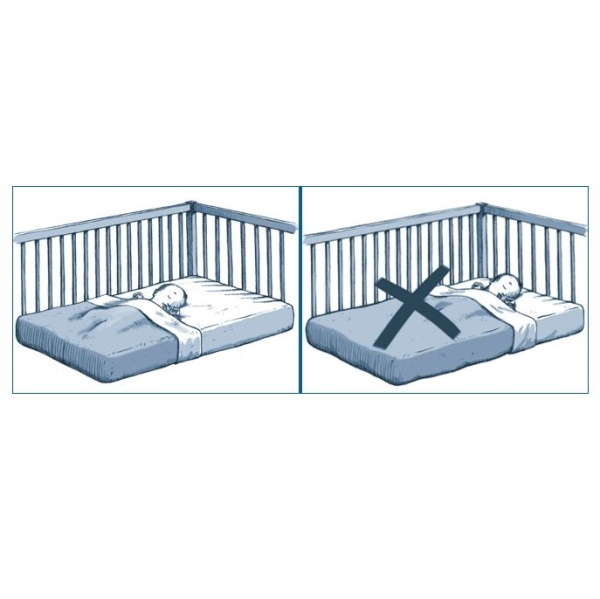How do I make a baby bed safely?
OverviewSafe sleeping for your baby: How to properly make a baby bed and ensure a safe sleeping environment
In the first months, your baby sleeps a lot, and that means that as a parent you have to pay extra attention to creating a safe sleeping environment. This not only includes choosing the right bedding and mattresses, but also ensuring an optimal night's sleep in a safe crib or crib. Safe sleep is crucial to your baby's health and well-being, and making a baby bed is an important part of this. Below you can read how to make a baby's bed properly and safely, as well as additional tips for creating a safe sleeping environment.
How do you make a baby bed?
We explain what you need to make your baby bed safely.
What do you need:
- Mattress
- Undersheet
- Sail
- Molton underlay or flannel diaper
- Hydrophilic diaper
- sheet
- Blanket
Steps for a safely made baby bed:
- Place the molton underlay over the entire mattress to protect the mattress.
- Pull the bottom sheet (cover) tightly over the flannel.
- To provide extra protection for the mattress, place a narrow crib sheet at the height of your baby's buttocks. Make sure there is no tarp under the head, as this can hinder breathing.
- Place an extra molton underlay or flannel diaper on top of the cover for extra comfort.
- Place a hydrophilic diaper under your baby's head, this will help catch spit-up without having to change the entire bed.
- Place the blanket about 8 inches (20 cm) below the top part of the sheet and fold it back. Make sure the edges are folded properly under the mattress.
Short make-up or sailor's bed?
For a safe sleeping environment, it is important to make the bed briefly. This means that the bedding reaches your baby's shoulders, so that his head remains free, the feet almost touch the end of the bed. This reduces the risk of your baby becoming tangled in the bedding. In the summer months you can safely use just a sheet or sleeping bag without a blanket.
An alternative name for short make-up is the so-called "sailor's bed", a reference to the narrow beds that sailors used to sleep in. This ensures a safe and comfortable sleeping environment for your baby.

Tips for a safe sleeping environment
In addition to safely making the baby's bed, there are other important guidelines to create a safe sleeping environment for your baby:
- Always put your baby to sleep on their back: Stomach sleeping increases the risk of cot death. Vary turning the head to the left or right to prevent flattening of the skull.
- Don't smoke around your baby: Smoking is a risk factor for SIDS.
- Don't dress your baby too warmly: Pajamas and sleeping bags are usually sufficient. Check your baby's temperature through her feet, not her head.
- Do not use a duvet for babies under 2 years old: Blankets are fine, but make sure the bedding is tucked in properly to prevent your baby from getting tangled up in it.
Safety tip: Limit the risk of cot death
SIDS is a tragic and often unexplained loss of a baby, usually during sleep. Fortunately, there are steps you can take to reduce the risk of SIDS:
Ensure a well-ventilated sleeping area: The ideal temperature in the baby's room is between 16 and 18 degrees.
Do not use pillows or large cuddly toys: These can hinder breathing or increase the risk of rebreathing.
Use a well-fitting sleeping bag: This prevents your baby from getting tangled in loose bedding.
Don't put your baby in bed with you: Use a separate crib or co-sleeper.
What is heat build-up?
Heat build-up occurs when your baby becomes too warm, for example due to thick bedding, clothes that are too warm, or a baby room that is too warm. This can lead to a body temperature that is too high, which is dangerous. Therefore, avoid electric blankets and do not use a duvet for babies under the age of two. Ensure a pleasant temperature in the room and check regularly that your baby is not too warm.
What is rebreathing?
Rebreathing occurs when your baby re-breathes his exhaled air, for example because he is lying too close to the bedding or a cuddly toy. This can lead to suffocation. Make sure that the bedding is breathable and that there are no objects in the bed that could increase this risk.
Conclusion
Creating a safe sleeping environment for your baby is essential for a good night's sleep and reducing risks such as cot death. By making a baby's crib briefly, adopting proper sleep habits, and paying attention to temperature regulation and using safe bedding, you can ensure that your baby sleeps in a safe and comfortable way. Always follow the guidelines of SafetyNL and Youth Health Care for creating an optimal sleeping environment.





